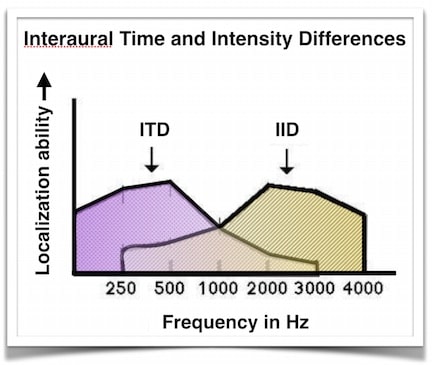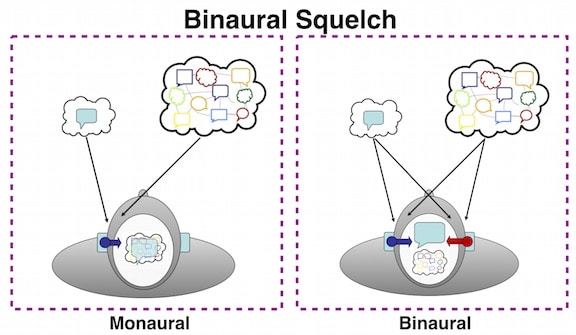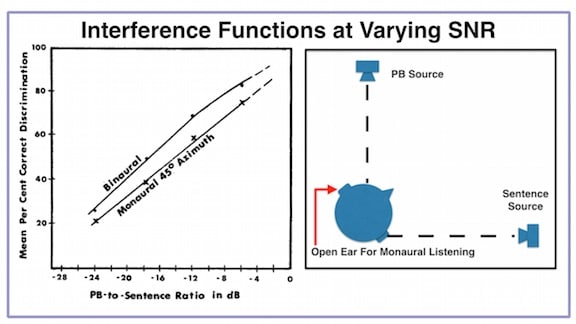 Studies have reported that listening with two ears is better than listening with one, especially in binaural understanding of speech in a noisy environment. This binaural advantage is believed to arise from a combination of head diffraction, redundancy, and binaural squelch effects. Head diffraction has been discussed previously, and binaural redundancy is being reserved for a future post. This post will concentrate on loudness squelch (identified in the literature also as, and related to: release from masking, masking level difference, facilitation in noise, cocktail party effect, and auditory figure ground).
Studies have reported that listening with two ears is better than listening with one, especially in binaural understanding of speech in a noisy environment. This binaural advantage is believed to arise from a combination of head diffraction, redundancy, and binaural squelch effects. Head diffraction has been discussed previously, and binaural redundancy is being reserved for a future post. This post will concentrate on loudness squelch (identified in the literature also as, and related to: release from masking, masking level difference, facilitation in noise, cocktail party effect, and auditory figure ground).
Binaural Hearing: Background
Previous posts have listed factors contributing to the benefit of binaural hearing, with a major contributing factor being that of head shadow. Instead of nullifying any potential binaural advantage by creating a physical barrier between the ears, the barrier created by the head separating a signal of interest (speech as an example) from noise can create an advantage. This is especially true if one ear is closer to the noise source, and then adding a second, or contralateral ear, resulting in a better signal-to-noise ratio (SNR). Listening with two ears benefits from the head shadow by focusing/attending to the ear with the better SNR.
The improved SNR reflects a combination of elimination of the head shadow effect (allowing for sound localization) and binaural squelch.
Spatial effects (spatial unmasking) of binaural hearing include the head shadow effect and the squelch effect. Both of these involve sounds arriving at the two ears in different ways (time and intensity) due to the acoustic shadow created by the head. Thus, the head shadow effect increases the signal-to-noise (SNR) because noise coming to a right ear would affect the right ear, but the head would cast an acoustic shadow to that sound reaching the left ear. As a result, the head shadow would increase the SNR to the left ear, meaning that the noise would not be as effective as a masker.
The head shadow is critical to sound localization. As presented in two previous posts, input from two ears allows a listener to identify the location of a sound in space. However, binaural hearing provides additional advantages, including binaural summation and binaural squelch.

Figure 1. Interaural time difference (ITD) and interaural intensity difference (IID) frequency involvement, showing that for the low frequencies the ITD contributes greatly to localization, while the IID contributes to localization via the high frequencies.
In head shadow, the head diffraction effects are frequency dependent, with high-frequency information (>1500 Hz) affected more than low-frequency information (<1000 Hz). This is because wavelengths of high-frequency information are short compared with the size of the head, and as a result, high frequencies are attenuated by about 20 dB or more as they cross around the head (Figure 1).
It is important to keep in mind that the head shadow is an acoustic phenomenon and not a neural process. In binaural squelch, the two sounds are integrated within the central nervous system – a neural process.
Practical Advantages of Hearing With Two Ears
The practical advantages of hearing binaurally occur almost exclusively when listening in competing sounds.
Binaural Squelch
Binaural squelch is the difference in performance between monaural listening of the ear with the better SNR and binaural hearing in the condition where the speech and noise are presented on opposite sides (Figure 2).
Binaural squelch leads to improved intelligibility and signal identification by taking advantage of differences between the competing signals to the ears (differences in time, level, spectrum, phase, etc.), due to the ears being spatially separated.
This is a dichotic effect, where dichotic means that sound presentations are different when presented to each ear. So, binaural squelch is the central nervous system’s ability to compare and integrate the different signals being received at each ear. The binaural squelch effect is a result of nuclei of the brainstem processing timing, amplitude, and spectral differences between the two ears. Sounds are integrated and then separated into auditory objects. For this effect to take place, neural integration from both sides is required.

Figure 2. Binaural squelch enables our brain to separate a speech signal from background noise and to give it more prominence for speech understanding in competing messages.
Listening most often involves at least one noise source, with incident sound generally more intense than is reflected sound. The result is that intra-aural phase and intensity relationships differ for speech and noise, and the central nervous system uses these differences to suppress environmental sounds and improve speech intelligibility. This is because speech and noise are received differently at the two ears, enhancing the signal and reducing the noise.
The binaural squelch effect is strongest for low-frequency sounds (up to 15 dB below 2500 Hz), and decreasing to 2-3 dB for frequencies above 2500 Hz (Carhart, 1965). This translates to an approximate 10% in word recognition scores for phonetically balanced (PB) words in the presence of a competing message(Figure 2, from Carhart, 1965). Carhart converted this difference into a subjective reduction in masking effectiveness by the competing signal, which was equivalent to 2.8 dB. He termed this reduction the binaural squelch factor. Restated, binaural loudness squelch would have reduced the masking (improved the SNR) by 2.8 dB over what the competing sound would have been during monaural direct reception. This was confirmed by Cox and Bisset.
The binaural squelch phenomenon, most pronounced in low frequencies (up to 15 dB below 2500 Hz), fine-tunes our auditory landscape, enhancing speech recognition by approximately 10% and carving a pathway through the auditory maze, reaffirmed by Cox and Bisset.
The practical implication of the difference between monaural and binaural listening is as follows: With monaural hearing and everyday listening, the signal coming to just one ear shifts back and forth between the two monaural states (direct or indirect listening), depending on where the sound is coming from. In this situation, when the monaural listening ear is unfavorably situated (speech to bad ear and noise to good ear), the listener is confronted with much greater masking from background noise. The handicap is reversed when the good ear is toward the primary signal and the bad ear is toward the noise. Binaural hearing provides an everyday advantage because with two ears, one does not have to rely on advantageous positioning of the ears. One ear will always be in an advantageous position – being on the proper side of the head. With two ears, the shadowing effect created by the head is essentially escaped.

Figure 3. Interference functions for presentation of NU Test 2 to sixteen subjects with normal hearing with loudspeakers placed at 450 azimuths. The primary signal was always at 32 dB hearing level. The binaural squelch is calculated as follows: The binaural function lies about 10% above the monaural function. The slope is 3.6%/dB. Dividing 10% by 3.6% yields 2.8, which may be taken as the magnitude of the binaural squelch (after Carhart, 1965).
Summary
Binaural squelch is used to increase SNR. The auditory signals from each ear are centrally combined. This central representation attempts to cancel the noise perceived at one ear with the attended signal received from the other ear. The amount of noise that can be suppressed depends on the amplitude and phase difference of the two signals.
Binaural hearing does not show tremendous SNR improvements, but it provides a significant practical advantage to monaural when in difficult listening situations.
Wayne Staab, PhD, is an internationally recognized authority in hearing aids. As President of Dr. Wayne J. Staab and Associates, he is engaged in consulting, research, development, manufacturing, education, and marketing projects related to hearing. His professional career has included University teaching, hearing clinic work, hearing aid company management and sales, and extensive work with engineering in developing and bringing new technology and products to the discipline of hearing. This varied background allows him to couple manufacturing and business with the science of acoustics to bring innovative developments and insights to our discipline. Dr. Staab has authored numerous books, chapters, and articles related to hearing aids and their fitting, and is an internationally-requested presenter. He is a past President and past Executive Director of the American Auditory Society and a retired Fellow of the International Collegium of Rehabilitative Audiology.
**this piece has been updated for clarity. It originally published on March 10, 2015







Thanks for the clear presentation on Squelch